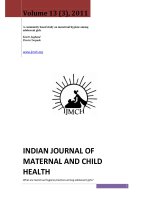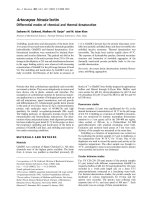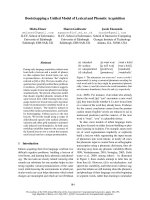DIAGNOSIS OF PREGNANCY AND PRENATAL CARE potx
Bạn đang xem bản rút gọn của tài liệu. Xem và tải ngay bản đầy đủ của tài liệu tại đây (580.8 KB, 50 trang )
103
The correct early diagnosis of pregnancy is often urgent. For ex-
ample, a diagnosis is essential to institute studies or treatment of
problems that may jeopardize the life or health of mother or off-
spring. Today this is usually accomplished by early beta-subunit
hCG testing or ultrasonic scanning because a definite clinical di-
agnosis of pregnancy before the second missed period is possible
in only about two thirds of patients. However, the practitioner must
be familiar with the signs and symptoms of pregnancy to properly
test for and treat the early pregnancy.
CLINICAL DIAGNOSIS
OF PREGNANCY
Traditionally, the clinical criteria for the diagnosis of pregnancy
have been categorized into presumptive, probable, and positive
(Table 5-1).
The differential diagnosis of the common signs and symptoms
of pregnancy involves other conditions associated with similar com-
plaints or alteration (Table 5-2).
PELVIC FINDINGS OF
EARLY PREGNANCY
Critical to the diagnosis of pregnancy by physical examination are
the pelvic findings. The presumptive indications of pregnancy
include the following.
Cyanosis of the vagina (Chadwick’s sign, Jacquemier’s sign) is
present by about 6 weeks.
5
DIAGNOSIS OF PREGNANCY
AND PRENATAL CARE
CHAPTER
Copyright 2001 The McGraw-Hill Companies. Click Here for Terms of Use.
BENSON & PERNOLL’S
104 HANDBOOK OF OBSTETRICS AND GYNECOLOGY
TABLE 5-1
PRESUMPTIVE OR PROBABLE SIGNS AND SYMPTOMS
OF PREGNANCY*
Symptoms Signs
Amenorrhea Leukorrhea
Nausea, vomiting Changes in color
Breast tingling, mastalgia consistency, size, or
Urinary frequency, urgency shape of cervix or
Quickening uterus
Temperature elevation
(usually by BBT)
Enlargement of abdomen
Breasts enlarged, engorged,
nipple discharge
Pelvic souffle (bruit)
Uterine contractions (with
enlarged corpus)
*
Although these may be suggestive, even Ն2 are not diagnostic of
pregnancy.
Softening of the tip of the cervix (Fig. 5-1) occasionally is noted
by the 4th–5th week of pregnancy. However, infection or scar-
ring may prevent softening until late pregnancy.
Softening of the cervicouterine junction often occurs by 5–6
weeks. A soft spot may be noted anteriorly in the middle of
the uterus near its junction with the cervix (Ladin’s sign) (Fig.
5-2). A wider zone of softness and compressibility in the lower
uterine segment (Hegar’s sign) is the most valuable sign of early
pregnancy and can usually be noted at ϳ6 weeks (Fig. 5-3).
Ease in flexing the fundus on the cervix (McDonald’s sign) gen-
erally appears by 7–8 weeks.
Irregular softening and slight enlargement of the fundus at
the site of or on the side of implantation (Von Fernwald’s
sign) occur by ϳ5 weeks. Similarly, if implantation is in the re-
gion of a uterine cornu, a more pronounced softening and sug-
gestive tumor like enlargement may occur (Piskacek’s sign)
(Fig. 5-4).
Generalized enlargement and diffuse softening of the uterine
corpus usually occur Ն8 weeks of pregnancy (Fig. 5-5).
CHAPTER 5
DIAGNOSIS OF PREGNANCY
105
TABLE 5-2
COMPARATIVE DIFFERENTIAL DIAGNOSIS
OF PRESUMPTIVE SYMPTOMS AND SIGNS
OF PREGNANCY
Cause(s) if Differential Diagnosis
Pregnant (Not Pregnant)
Symptoms
Amenorrhea hCG, etc. Pseudocyesis or
other
psychoneurosis,
endocrinopathies
(including
premature
menopause),
metabolic
disorders (e.g.,
anemia,
malnutrition),
obliteration of
the uterine
cavity, systemic
disease (e.g.,
acute or chronic
infection),
malignancy
Nausea, hCG, etc. Emotional
vomiting disorders (e.g.,
pseudocyesis,
anorexia
nervosa), GI
disorders
(gastroenteritis,
peptic ulcer,
hiatal hernia,
appendicitis,
intestinal
obstruction, food
poisoning),
acute infections
(e.g., influenza,
encephalitis)
(Continued)
BENSON & PERNOLL’S
106 HANDBOOK OF OBSTETRICS AND GYNECOLOGY
TABLE 5-2
(Continued)
Cause(s) if Differential Diagnosis
Pregnant (Not Pregnant)
Mastalgia, Estrogen Estrogen with
breast tingling (duct anovulation,
stimulation), fibrocystic
progesterone breast disease
(alveolar
stimulation)
Urinary urgency, Estrogen Urinary tract
frequency (cystourethral infection (UTI),
turgescence) cystourethritis or
cystocele,
anxiety,
diabetes,
pelvic tumors,
emotional
tension
Quickening Fetal movements Increased
Ͼ14 weeks peristalsis, free
(approx.) adnexal cyst,
pseudocyesis,
gas, contractions
Constipation Altered diet; Low fluid, low
hypoperistalsis fiber diet
Fatigue Progesterone Overwork
effect
Weight gain Gestational Overeating
anabolism
Signs
Leukorrhea Estrogen Vaginitis,
cervicitis,
genital foreign
body, tumor
Pelvic organ
alterations
Cyanosis of Hormones Vascular anomaly
cervix or of pregnancy or tumor of
Chadwick’s cervix or uterus
sign (Ͼ6 weeks)
CHAPTER 5
DIAGNOSIS OF PREGNANCY
107
Softening of Hormones Chronic cervicitis
cervix of pregnancy
(Ͼ4–5 weeks)
Softening of Hormones Vascular uterine
lower uterine of pregnancy anomaly or
segment (Ͼ5–6 tumor
weeks), Landin,
Hegar’s sign
Irregular Hormones Myoma
fundal of pregnancy
softening,
enlargement
(Ͼ5 weeks)
Generalized Hormones Adenomyosis or
corpus of pregnancy myomata
softening,
enlargement
(Ͼ8 weeks)
Temperature Progesterone Infection, corpus
elevation basal luteum cyst,
body temperature hCG or
(BBT) Ͼ2 weeks progestogen
therapy, faulty
thermometer
Abdominal Uterine size Obesity, pelvic or
enlargement abdominal
tumor, ascites,
obesity,
relaxation of
abdominal
muscles,
pelvic and
abdominal
tumors, ascites,
or ventral
hernia
(Continued)
TABLE 5-2
(Continued)
Cause(s) if Differential Diagnosis
Pregnant (Not Pregnant)
BENSON & PERNOLL’S
108 HANDBOOK OF OBSTETRICS AND GYNECOLOGY
Breast changes
Enlargement, Estrogen and Mastitis,
engorgement, progesterone malignancy,
secondary PMS,
areola pseudocyesis
(Ͼ6–8 weeks)
Colostrum Prolactin, Hypothalamic
(Ͼ16 weeks) progesterone galactorrhea
excess
Pelvic souffle Increased pelvic Pelvic tumor or
(bruit) blood flow vascular
anomaly
(aneurysm)
Uterine Braxton-Hicks Pseudocyesis,
contractions contractions tightening–
(with enlarged relaxation of
uterus) abdominal
muscles
Skin Pituitary
pigmentation melanotropin Ultraviolet
(chloasma, linea exposure
nigra) (tanning)
Epulis Progesterone Gingivitis
(Ͼ12 weeks)
TABLE 5-2
(Continued)
Cause(s) if Differential Diagnosis
Pregnant (Not Pregnant)
ABDOMINAL FINDINGS
OF EARLY PREGNANCY
Active movements usually are palpable Ն18 weeks. By the 16th–
18th week, passive movements of the fetus may be elucidated by
abdominal and vaginal palpation. A firm tap on the uterine wall or
vaginal fornix displaces the fetus as a floating body. An impulse
then can be felt as a thrust as the fetus moves back to its former
position (ballottement). Ascites and tumors must be excluded. After
the 24th week, the fetal outline may be palpated in many pregnant
women.
CHAPTER 5
DIAGNOSIS OF PREGNANCY
109
FIGURE 5-1. Softening of the cervix.
FIGURE 5-2. Ladin’s sign.
FIGURE 5-3. Hegar’s sign.
FIGURE 5-4. Piskacek’s sign.
110
No subjective evidence of pregnancy is totally diagnostic, how-
ever, and laboratory diagnosis is essential.
LABORATORY EVIDENCE OF PREGNANCY
BETA-SUBUNIT hCG
Assays for beta-subunit hCG, commonly used to diagnose preg-
nancy, have an admitted failure rate (ϳ1%). Moreover, they may
be positive in nongestational ovarian choriocarcinoma or in un-
common gastrointestinal or testicular tumors. Nevertheless, a pos-
itive beta-subunit hCG test may be considered reasonable proof of
pregnancy. A true positive followed by a true negative pregnancy
test may indicate abortion. The major methods for determining the
beta-subunit hCG are as follows.
CHAPTER 5
DIAGNOSIS OF PREGNANCY
111
FIGURE 5-5. Bimanual pelvic examination.
BENSON & PERNOLL’S
112 HANDBOOK OF OBSTETRICS AND GYNECOLOGY
IMMUNOLOGIC TESTS
Immunologic tests for pregnancy (Table 5-3) are based on hCG’s
antigenic potential (direct or indirect agglutination of sensitized
RBC or latex particles). These tests require slides or test tubes for
reagents and take from a few minutes to over an hour to complete.
Test sensitivities vary widely (250–1400 mIU/mL).
Radioimmunoassay (RIA)
The hCG radioimmunoassay (RIA) requires a gamma counter for
the highest sensitivity. The test, reportable in Ͻ90 min is extremely
accurate (ϳ20 mIU/mL.) Thus, it usually is used when sensitivity
is crucial.
Radioreceptor Assay (RRA)
The RRA measures the biologic activity by in vitro binding of hCG
to bovine corpus luteum membrane. Unfortunately, hCG and hLH
cannot be separated by RRA. A commercially available RRA, Bio-
cept G, has set its negative endpoint high to avoid false positive re-
ports. The accuracy does not approach that of RIA or ELISA.
Enzyme-Linked Immunoabsorbent Assay (ELISA)
A specified monoclonal antibody produced by hybrid cell technol-
ogy is used for the ELISA assay. With ELISA, the enzyme induces
a color change indicating the hCG level. ELISA is simple and rapid
TABLE 5-3
IMMUNOLOGIC TESTS FOR PREGNANCY
Method Materials Results
Direct Latex particles Coagulation if
coagulation coated with anti- hCG is present
hCG ϩ serum or (pregnant)
urine
Inhibition of Anti-hCG ϩ serum Coagulation if
coagulation or urine hCG is absent
plus (not pregnant);
Sensitized red cells inhibition if
or hCG is present
Latex particles (pregnant)
coated with hCG
(5 min), no isotopes are used, and it can be an office (serum) test
(e.g., Prognosis slide test, which measures to 1.5–2.5 mIU/mL). The
tube, office or home test (e.g., Preco Rapid Care) measures only to
1.0 mIU/mL. Nevertheless, even ELISA home kits are at least 90%
accurate within the range mentioned.
RIA, RRA, or ELISA can be used for the diagnosis of preg-
nancy as early as 8–12 days after ovulation. hCH has a doubling
time of 1.2–2.5 days during the first 10 weeks of pregnancy, with a
slow decline to about 5000 mIU/mL thereafter.
The latest beta-specific latex tube or slide tests that are based
on agglutination or agglutination-inhibition are still adequate for the
diagnosis of normal pregnancy Ͼ1–2 months. The ELISA test usu-
ally picks up earlier gestations and is more accurate, although af-
ter pregnancy, an ELISA test may require weeks to become nega-
tive. Therefore, RIA will continue to be the method employed for
serial quantitative studies in problem pregnancies, particularly
trophoblastic disease.
ULTRASONOGRAPHY
Typically, early first trimester ultrasound has four objectives:
●
Locate, measure, and observe the configuration of the ges-
tational sac (mean sac diameter, MSD ϭ length ϩ width ϩ
height/3),
●
Identify embryo(s), document fetal number, and record pres-
ence or absence of life (usually determined by heartbeat),
●
Determine the extent of fetal development and measure the
crown-rump length (CRL),
●
Evaluate the uterus, cervix and adnexa.
Currently, endovaginal ultrasonic detection of the implanted
products of conception is possible when the MSD is 2–3 mm. This
occurs at ϳ4 wk 3 d menstrual age (MA) and the hCG is character-
istically 500–1500 IU/mL. Generally, transabdominal ultrasound will
detect the gestational sac at 5 mm MSD (ϳ5 wk MA). At this time,
the endometrium is markedly echogenic with prominent arcuate ves-
sels. The sonolucent gestational sac is surrounded by trophoblastic
decidual reaction that sonographically appears as a hyperechoic rim
(or rind). In a normal early pregnancy, the mean gestational sac di-
ameter increases by ϳ1.2 mm/day. To determine the gestational age
(in days), add 30 to the mean gestational sac diameter: a mean sac
diameter of 20 mm corresponds to a gestational age of 50 days.
The yolk sac is often the first sonographic structure visualized
within the gestational sac (from MSD 10–15 mm, 40–45 d MA). The
CHAPTER 5
DIAGNOSIS OF PREGNANCY
113
BENSON & PERNOLL’S
114 HANDBOOK OF OBSTETRICS AND GYNECOLOGY
yolk sac is frequently visualized as a “double bleb” with the am-
niotic sac. The dorsal yolk sac incorporates into the primitive gut
and the secondary yolk sac detaches from the midgut loop by the
end of the 8th week MA. The yolk sac increases to a maximum of
ϳ5 mm at 11 weeks MA and disappears by 14–15 weeks MA.
The embryo may be ultrasonically visualized at a CRL of 2–3.9
mm (34–40 d MA). There is generally cardiac activity by 22–36 d
when the embryo is 1.5–3 mm. An important correlation is that
fetuses destined to progress will have cardiac activity by CRL of
5 mm. At this time, the MSD is 15–18 mm and the MA is 6.5 wk.
Generally, the early fetal heartbeat is more rapid (160 bpm) and
slows with gestation. Near term, the rate is 120–140 bpm.
By CRL of 12 mm the head should be discernable from the tho-
rax. Limb buds develop by 8 weeks MA. During the interval of
8–10 week, MA there is rapid embryonic development. At 11 week
MA (9 wk from conception), the embryo is 20–35 mm CRL and is
termed a fetus.
Early pregnancy ultrasonography may reveal findings that in-
dicate fetal compromise or impending fetal loss. Examples of such
findings include the following.
●
Fetal developmental disorganization (or dissolution) and
lack of a heartbeat is associated with virtually 100% fetal
loss, particularly if previous development and heart activity
had been sonographically determined.
●
Decreased amniotic fluid (evidenced by small gestational
sac size) is associated with a 94% spontaneous abortion
rate.
●
A MSD (mm) minus CRL (mm) of Ͻ5 is associated with
an 80% spontaneous loss.
●
Absence of an embryo in a gestational sac with MSD
Ͼ25 mm is associated with 45% abortion rate.
●
An intrauterine hematoma is associated with ϳ25% abor-
tion incidence.
Ultrasonic examination is often utilized to evaluate a first
trimester pregnancy complicated by vaginal bleeding. Given an
embryo with satisfactory development and a heart beat, there is
roughly double the risk of spontaneous abortion when vaginal
bleeding complicates a first trimester pregnancy [e.g., Ͻ6 wk there
is a 33% abortion risk with bleeding (vs. 16% without bleeding), at
7–9 wk there is a 10% abortion risk with bleeding (vs. 5%), and
at 9–11 wk there is a 4% chance of bleeding (vs. 1%–2% without
bleeding)].
The sonographic differential diagnosis of early pregnancy in-
cludes: bleeding, endometritis, endometrial cysts, cervical stenosis,
and the pseudogestational sacs associated with ectopic pregnancy.
Additionally, sonographic pitfalls to be avoided in the first trimester
include: incorrect assessment of fetal number (somewhat obviated
by fetal, not sac, visualization), the inability to accurately deter-
mine eventual placental placement, and difficulty in assessment
of morphologic abnormalities. Examples of the latter requiring
accommodation include: the early integument simulating edema,
the natural extraabdominal intestinal phase, and difficulty in deter-
mining ultimate fetal cranial development that can lead to a false
diagnosis of anencephaly. Although initially thought to be most ac-
curate, caution must be exercised in sonographic gestational dating
accomplished in the first trimester, for it is now apparent that thor-
ough second trimester assessment, when more parameters can be
measured, may be more exact.
DURATION OF PREGNANCY
AND EXPECTED DATE
OF CONFINEMENT
ESTIMATED DATE OF CONFINEMENT
After a positive diagnosis, the duration of pregnancy and the esti-
mated date of confinement (EDC) must be determined. Because it
is uncommon to know the exact onset of pregnancy, these calcula-
tions start from the first day of the last menstrual period (LMP).
Pregnancy in women lasts about 10 lunar months (9 calendar
months). The average length of pregnancy is 266 days. The median
duration of pregnancy is 269 days. However, only ϳ6% of patients
will deliver spontaneously on their EDC. Most (60%) will deliver
within 2 weeks of the EDC. Thus, as in most physiologic events,
term should be regarded as a season or period of maturity, not a
particular day.
A major variable in the calculated duration of pregnancy is rec-
ognized because not all women have a 28-day cycle. Hence, the
physician also must consider the length of her cycle. A patient with
a regular 40-day cycle obviously will not ovulate on day 14 but
closer to or on day 26. Therefore, her EDC cannot be estimated
accurately by Nagele’s rule alone. Moreover, some women tend to
have long or short gestations as a familial predisposition. Primi-
paras tend to have slightly longer gestations than multiparas. Thus,
the EDC cannot be calculated precisely, although the following clin-
ical approximations have proven useful.
CHAPTER 5
DIAGNOSIS OF PREGNANCY
115
BENSON & PERNOLL’S
116 HANDBOOK OF OBSTETRICS AND GYNECOLOGY
NAGELE’S RULE
Add 7 days to the first day of the LMP, subtract 3 months, and add
1 year.
EDC ϭ (LMP ϩ 7 days) Ϫ 3 months ϩ 1 year
For example, if the first day of the LMP was June 4, the EDC will
be March 11 of the following year.
Nagele’s rule is based on a 28-day menstrual cycle with ovula-
tion occurring on the 14th day. In calculating the EDC, an adjust-
ment should be made if the patient’s cycle is shorter of longer than
28 days. The discrepancies caused by 31-day months and the 29-day
variation in February of leap year are not correctable by Nagele’s
rule. Nevertheless, it provides an acceptable estimate of the EDC.
HEIGHT OF FUNDUS AS
MEASURED ABDOMINALLY
The uterus increases from a nonpregnant length ϳ7 cm to 35 cm
at term; it increases 20 times in weight and grows in volume from
500–1000 times. Thus, the size of the uterus should be evaluated
at each prenatal visit to determine the normality of progress. Most
examinations involve an estimate of the height of the fundus uteri
on the abdomen, not the length of the uterus. The superior ramus
of the pubis, the umbilicus, and the xiphoid are the fixed reference
points from which the height of the fundus is measured. A rough
rule is provided by Table 5-4, and a more precise estimation can be
made by the modified McDonald’s rule.
TABLE 5-4
UTERINE HEIGHT AND STAGE OF GESTATION
Week of Pregnancy Approximate Height of Fundus
12 Just palpable above symphysis
15 Midpoint between umbilicus and
symphysis
20 At the umbilicus
28 6 cm above the umbilicus
32 6 cm below the xiphoid
36 2 cm below the xiphoid
40 4 cm below the xiphoid
Unusually large measurements suggest an incorrect date of con-
ception, multiple pregnancy, fetal macrosomia, fetal defect, or poly-
hydramnios. Unexpectedly small measurements imply fetal death,
fetal undergrowth, developmental abnormality, or oligohydramnios.
MODIFIED MCDONALD’S RULE
Measure the height of the fundus (over the curve) above the
symphysis with a centimeter tape measure. The distance in cen-
timeters will approximate the gestational age from 16–38 weeks
Ϯ3 weeks.
The same examiner should measure the fundus whenever pos-
sible because variations by personnel may inaccurately suggest
pregnancy complications.
Additionally, a rough guide to fetal weight may be calculated
from the modified McDonald’s uterine measurement (Johnson’s
rule). However, recall that wide variations in the weights of fetuses
in the third trimester may be due to the following.
●
The age-weight patterns of previous infants
●
An expected increase in weight of each successive infant
●
Hereditary traits or acquired disorders affecting infant size,
for example, race, nutrition, diabetes mellitus, preeclampsia-
eclampsia.
JOHNSON’S ESTIMATE
OF FETAL WEIGHT
Fetal weight (in grams) is equal to the fundal measurements (in
centimeters) minus n, which is 12 if the vertex is at or above the
ischial spines or 11 if the vertex is below the spines, multiplied
by 155.
Example: A gravida with a fundal height of 30 cm whose vertex
is at Ϫ2 station can be represented as (30 Ϫ 12) ϫ 155 ϭ 2790 g. If
the patient weighs Ͼ200 pounds, subtract 1 cm from the fundal meas-
urement. By this calculation, an estimate within 375 g can be ex-
pected for about 70% of neonates.
QUICKENING
A rough estimate of the EDC is possible by adding 22 weeks to the
date of quickening in a primigravida or 24 weeks in a multipara.
As in attempting to diagnose pregnancy, the most accurate data
for EDC are provided by clinical, laboratory, and ultrasonographic
studies.
CHAPTER 5
DIAGNOSIS OF PREGNANCY
117
BENSON & PERNOLL’S
118 HANDBOOK OF OBSTETRICS AND GYNECOLOGY
EARLY hCG TESTING
Determinations of beta-subunit hCG in maternal serum compared
with a scale of predetermined quantitative values provide the most
accurate estimate of gestational age during the first 8–10 weeks.
After this, hCG levels slowly decrease, and the method becomes
inaccurate.
BIRTH DEFECT SCREENING
PROGRAMS
GENERAL
The purpose of birth defect screening is to identify birth defects as
early in pregnancy as possible. This identification allows for all op-
tions open to the parents to be available, certain conditions to be
treated or their impact minimized, and birth care as well as neona-
tal intervention optimalization. Of course, the technology does not
currently exist to detect all birth defects, but a vigilant search will
reveal most. In many ways, birth defect screening has become a
portion of standard prenatal care. For example, prenatal historical
screening for those at greater risk of fetal defects has become well
accepted in circumstances of advanced parental age, a specific fa-
milial history, or prior reproductive problems. Additionally, many
providers now perform a patient-elected biochemical screening and
ultrasound scanning.
The age screening, prior reproductive screening, and historical
screening are generally done on the patient’s first antenatal visit.
Commonly, those gravidas .32 years of age at the time of their EDC
are considered to be of advanced maternal age (AMA). Every pa-
tient’s previous reproductive history is reviewed for any recidive
event (including multiple spontaneous abortions) or potentially in-
heritable disorder (mendelian or multifactorial). A three-generation
family history for mental retardation in males, previous congenital
anomalies, and previous chromosomal abnormalities is performed.
Many providers utilize a self-administered genetic screening ques-
tionnaire for this purpose.
Patients of African-American ancestry are customarily offered
screening for sickle cell trait or disease. If the mother is positive
for trait or disease, the father is also screened. If both have sickle
cell disease or sickle cell trait, an amniocentesis is commonly of-
fered to detect the sickle cell status of the child.
Maternal serum analyte screening for Down syndrome as well
as open neural tube defects has been described as “an integral com-
ponent of contemporary antenatal care.” In the United States, mul-
tiple marker screening has commonly included maternal serum
alpha fetoprotein (MSAFP), total human chorionic gonadotropin
(hCG), and unconjugated estriol (UE
3
). They are usually accom-
plished at 15–20 weeks gestation. Significant risk of Down syn-
drome is customarily those at Ͼ1:295 risk, whereas risk of open
neural tube defect (NTD) generally are those that exceeded 2 mul-
tiples of the mean value (MOM). When abnormal multiple marker
test results are obtained, reverification of gestational age (usually
by ultrasound) is necessary, for a very common problem is incor-
rect gestational age. Multiple marker screening has proven useful
for the purposes it was intended (detection of Down syndrome,
detection of open NTD, and detection of trisomy 18) as well as
assisting in detection of certain cases of intrauterine fetal demise,
multiple gestation, and erroneous gestational dates.
Other markers are available; for example, in the United
Kingdom maternal serum free beta-hCG and pregnancy-associated
plasma protein-A (PAPP-A) are utilized, and allow more rapid
analysis. In one study, this added an additional 16% to the detec-
tion rate accomplished by nuchal thickness and maternal age screen-
ing. Combining the four tests in screening for Down syndrome, the
detection rate is reported to be 75.8%–89% with false-positive rates
of ϳ5%.
Many authorities recommend that every gravida receive at least
one ultrasound, commonly at 16–20 weeks gestation, geared to
screen for fetal defects, ascertain multiple gestation, and determine
placental location. The latter two objectives are easily met; how-
ever, there is a sizable discrepancy in reported detection of fetal
malformations. This may be due to widely different levels of ex-
perience among sonographers as well as the difficulty to detect
certain defects.
NUCHAL TRANSLUCENCY
THICKNESS SCREENING FOR
CHROMOSOMAL ANOMALIES
An important series of recent observations indicate the desirability
of sonographic screening earlier than the second trimester, that is
to say, at 10–14 weeks. These studies indicate that measuring nuchal
translucency thickness is a method of screening for chromosomal
anomalies (notably trisomy 21 and trisomy 18) and other disorders.
CHAPTER 5
DIAGNOSIS OF PREGNANCY
119
BENSON & PERNOLL’S
120 HANDBOOK OF OBSTETRICS AND GYNECOLOGY
Indeed, in both high risk and low risk groups, the positive predica-
tive value of enhanced nuchal translucency is sufficient to warrant
suggesting further prenatal diagnostic testing. Because most cases
are discovered after the most appropriate time for chorionic villus
sampling (CVS), the majority of cases are further evaluated by
amniocentesis.
The screening is recommended at 10–14 weeks and most au-
thors use a nuchal thickness of Ͼ2.5–3 mm (depending on stage of
gestation) as abnormal. Cumulate studies indicate a sensitivity of
ϳ77% and a false positive rate of ϳ10% for aneuploidy. Selection
of patients for invasive testing by this method alone allows the de-
tection of about 80% of affected pregnancies. However, using this
method for selection of patients requires about 30 invasive tests for
identification of one affected fetus. Observation of a thickening that
subsequently resolves is not reassuring. Fetuses with normal
karotype and enhanced nuchal thickness have greater rates of spon-
taneous abortion related to the amount of thickness (3-fold increase
with 3.0–3. 9 mm thickening and nearly seven fold increase for
Ͼ4 mm).
The mechanism(s) creating enhanced nuchal thickness are not
completely defined. It appears, however, that impairment of atrial
contractility is involved. This has been implicated in cases of chro-
mosomal aneuploidy as well as in cases of cardiac failure (e.g., the
anemia associated with beta-thalassemia), heart, and/or great vessel
defects. In the case of major congenital cardiac defects, the posi-
tive and negative predictive values have been stated to be 1.5% and
99.9% respectively. Another suggested mechanism for increased
nuchal thickness is intrathoracic compression-related pulmonary
hypoplasia, as seen with diaphragmatic hernia.
A potential confounder to the measurement of nuchal translu-
cency thickness is the ϳ8% of fetuses having a nuchal cord at 10–14
weeks gestation. This potential bias may be reduced by use of color
Doppler to confirm nuchal cord and the average 0.8 mm cord thick-
ness subtracted.
Currently, nuchal translucency thickness sonographic screening
is not a substitute for the more standard care of multiple-marker
serum screening. It has not been recommended as an alternative
to genetic counseling and CVS or amniocentesis in women of
advanced maternal age or those with significant risk of aneuploidy.
Additionally, data concerning the false negative rate (i.e., a normal
nuchal translucency with aneuploidy or significant structural defect)
in a risk population is not sufficient to warrant replacement of
invasive testing. Indeed, it may be that combining the various
modalities will prove most efficient in screening for chromosomal
abnormalities.
SECOND AND THIRD
TRIMESTER SONOGRAPHY
Although it is not the purpose of this text to comprehensively review
ultrasonography, certain basics may assist the reader. The objectives
of later pregnancy ultrasound include the following:
●
Determine fetal life, number, and presentations.
●
Estimate the amount of amniotic fluid.
●
Determine the placental location, appearance (grade), and
relation to the internal cervical os.
●
Assess the gestational age using a variety of fetal measure-
ments.
●
Perform a fetal anatomic survey.
●
Evaluate the uterus and adnexa (including documentation of
size, type, and location of uterine or adnexal abnormalities).
The examination should note abnormal heart rate and/or rhythm
as well as a four-chamber view of the heart, including the heart’s
position within the thorax. Additionally, from 16–18 weeks on, eval-
uation of the cardiac outflow tracts may be useful.
Estimation of gestational age requires several measurements.
Both the biparietal diameter (BPD) and the head circumference
(HC) are measured at a level including the cavum septi pellucidi
and the thalamus. In cases of cephalic configuration abnormality
(brachycephaly or dolichocephaly), the cephalic index (BPD to
fronto-occipital diameter ratio) may be useful. The abdominal cir-
cumference (AC) is determined at the level of the umbilical vein
and portal sinus junction. The HC/AC ratio is useful in determina-
tion of fetal growth pattern. After the 14th week of gestation, and
despite considerable variation, both femur and humerus lengths are
useful in estimation of gestational size and dates.
In addition to the previous measurements, the fetal anatomic
survey usually includes: cerebral ventricles, spine, stomach, urinary
bladder, renal region, and the umbilical cord insertion site on the
anterior abdominal wall. Ultrasonic examination of Multiple preg-
nancies should note the placental number, sac number, presence or
absence of an interposed membrane, and comparison of fetal sizes.
Whereas limited examinations may be useful in clinical emer-
gencies or as a follow-up to a complete examination, the more
detailed sonography is generally more useful. In some circum-
stances (e.g., potential intrauterine growth retardation, potential
macrosomia) serial interval examinations are helpful in diagnosis
and management. More specialized (targeted) sonography is use-
ful in evaluation of potential fetal defects.
CHAPTER 5
DIAGNOSIS OF PREGNANCY
121
BENSON & PERNOLL’S
122 HANDBOOK OF OBSTETRICS AND GYNECOLOGY
Early (Ͻ20 weeks) ultrasonographic measurements of the fetal
BPD, AC, CRL, FL, or total uterine volume have been correlated
accurately with gestational age. Fetal growth between 20 and 30
weeks is rapid and linear, and there is marked third trimester vari-
ability in fetal size (as noted previously). Hence, initial measure-
ments should be taken and recorded as early as possible with sub-
sequent later determinations. A comparison of these diameters with
standard curves can estimate the gestational age Ϯ11 days with 95%
confidence. When only one measurement is possible or when ini-
tial measurements are obtained after the 30th week, accuracy is
reduced.
PRENATAL CARE
Prenatal care, the management of pregnancy, has numerous pur-
poses.
●
To ensure, as far as possible, an uncomplicated pregnancy
and the delivery of a live healthy infant.
●
To identify and institute care for any risk state.
●
To individualize the level of care necessary.
●
To assist the gravida in her preparation for labor, delivery,
and childrearing.
●
To screen for common diseases that may affect the gravida’s
or child’s life or health.
●
To reinforce good health habits for the gravida and her
family.
To achieve these, admittedly, ideal goals require an organized
and thoughtful approach. Indeed, to be maximally effective, pre-
natal care begins before conception. Although not the only way to
provide prenatal care, the following is intended as a guide or func-
tional method that has assisted in fulfilling the stated purposes.
Standard record forms are commercially available. These, com-
pleted with explanations when indicated, will amass most of the
necessary information. Thus, it is important to identify those data
that should be recorded.
GENERAL INFORMATION
Record the patient’s correct name, address, birth date, telephone
number(s), choice of whom to call in an emergency, and special
personal preferences.
TABLE 5-5
EMBRYONIC AND FETAL GROWTH AND DEVELOPMENT
Fertilization Crown- Crown-
Age rump heel
(Weeks) Length* Length* Weight* Gross Appearance Internal Development
Embryonic
stage
1 0.5 mm 0.5 mm — Minute clone free Early morula, no organ
in uterus differentiation
22 mm 2 mm — Ovoid vesicle
superficially buried in External trophoblast, flat embryonic
endometrium disk forming 2 inner vesicles
(amnioectomesodermal and
endodermal)
33 mm 3 mm — Early dorsal concavity Optic vesicles appear, double heart
changes to convexity; recognized, fourteen mesodermal
head, tail folds form; somites present
neural grooves close
partially
(Continued)
123
TABLE 5-5
(Continued)
Fertilization Crown- Crown-
Age rump heel
(Weeks) Length
*
Length
*
Weight
*
Gross Appearance Internal Development
44 mm 4 mm 0.4 g Head is at right angle Vitelline duct only communication
to body; limb rudiments between umbilical vesicle and
obvious, tail intestines, initial stage of most
prominent organs has begun
8 1.7 cm 3.5 cm 2 g Eyes, ears, nose, mouth Sensory organ development well
recognizable, digits along, ossification beginning in
formed, tail almost occiput, mandible, humerus
gone (diaphysis), and clavicles, small
intestines coil within umbilical cord,
pleural, pericardial cavities forming,
gonadal development advanced
without differentiation
Fetal stage
12 5.8 cm 11.5 cm 19 g Skin pink, delicate, Brain configuration roughly
resembles a human complete, internal sex organs now
124
(Continued)
being, but head is specific, uterus no longer bicornuate,
disproportionately blood forming in marrow, upper
large cervical to lower sacral arches and
bodies ossify
16 13.5 cm 19 cm 100 g Scalp hair appears, fetus Sex organs grossly formed,
active, arm–leg ratio myelinization, heart muscle well
now proportionate, developed, lobulated kidneys in
gender determination final situation, meconium in
possible bowel, vagina and anus open,
ischium ossified
20 18.5 cm 22 cm 300 g Legs lengthen Sternum ossifies
appreciably, distance
from umbilicus to
pubis increases
24 23 cm 32 cm 600 g Skin reddish and Os pubis (horizontal ramus) ossifies,
wrinkled, slight viability possible
subcuticular fat,
vernix, primitive
respiratory-like
movements
125
TABLE 5-5
(Continued)
Fertilization Crown- Crown-
Age rump heel
(Weeks) Length
*
Length
*
Weight
*
Gross Appearance Internal Development
28 27 cm 36 cm 1100 g Skin less wrinkled; more Testes at internal inguinal ring
fat, nails appear, if or below, astragalus ossifies
delivered, may survive
with optimal care
32 31 cm 41 cm 1800 g Fetal weight increased Middle fourth phalanges ossify
proportionately more
than length
36 35 cm 46 cm 2500 g Skin pale, body rounded, Distal femoral ossification
(for lanugo disappearing, hair centers present
Caucasian) fuzzy or wooly, earlobes
soft with little cartilage,
umbilicus in center of
body, scrotum small with
few rugae, few sole
creases
126
40 40 cm 52 cm 3200ϩ g Skin smooth and pink, Proximal tibial ossification
copious vernix, moderate centers present, cuboid, tibia
to profuse silky hair, (proximal epiphysis) ossify
lanugo hair on shoulders
and upper back, earlobes
stiffened by thick cartilage,
nasal and alar cartilages,
nails extend over tips of
digits, testes in full,
pendulous, rugous scrotum,
or labia majora well
developed, creases cover
sole
*
Approximate.
127









